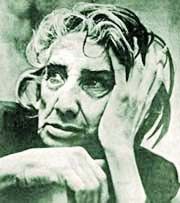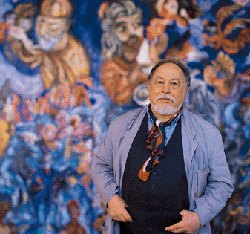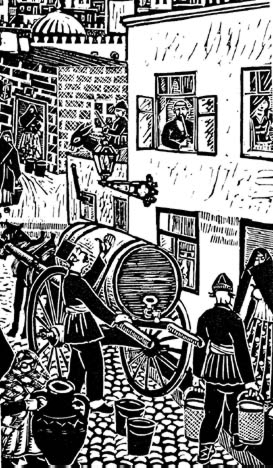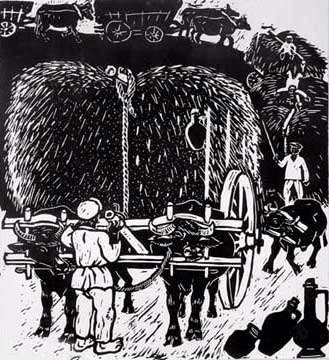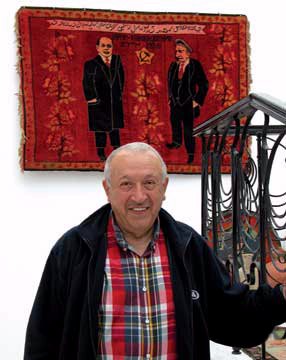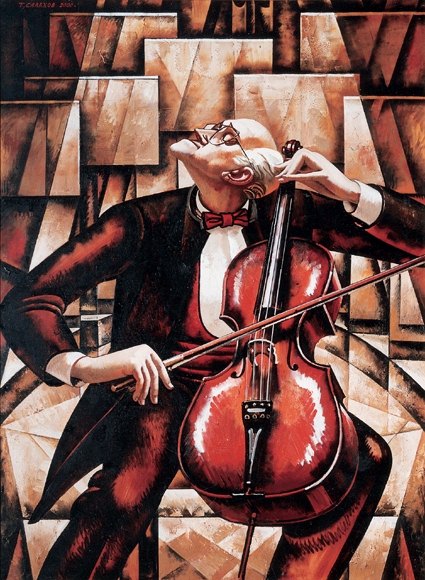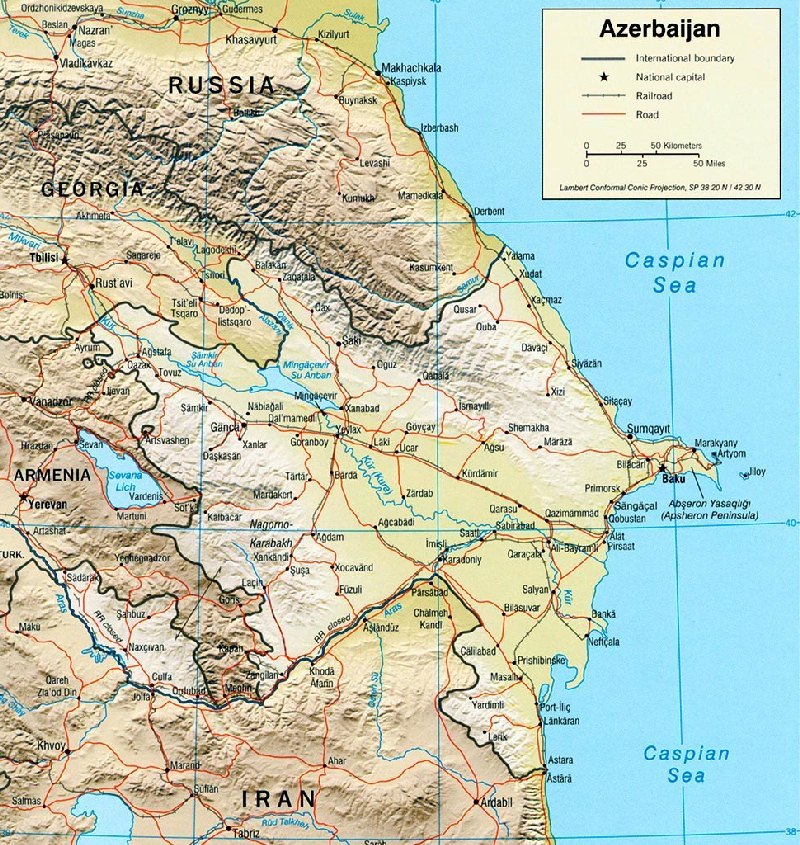| Azerbaijani Artists
The Art History Archive - Soviet Art
Sattar BahlulzadeSattar Bahlulzade or Bahlulzadeh (Born December 15th 1909 - Died 1974) is the founder of contemporary Azerbaijani landscape painting. He began his professional education at the National Art Institute in Baku (1927-1931). In 1933, he went to Moscow to continue his education in the Drawing Department at the Moscow Fine Arts Institute. There he studied in the studio of V.A. Favorsky. During the summer workshops in Crimea, Russian painter Marc Chagall saw some of Sattar's sketches and suggested that he transfer to the Institute's Painting Department. So he did. Though he experimented in various genres of art, his unique talent was landscape painting. At first, he used to paint nature realistically as he had been taught. But soon he developed his own style to express the emotional feeling it invoked in him. This new style was more surreal and cosmic. In fact, some of his paintings are reminiscent of photos of the earth taken from space. Using a combination of pastel colors and bold strokes, he made nature look more colorful and lively, and sometimes even more fantastic, than it did in reality. Sattar loved to travel around his country – Azerbaijan – exploring its beauty. Once he remarked, "I don't need to go to Tahiti like Gauguin. My inspiration comes from my own country and people." Many of his works depict specific areas of Azerbaijan. For instance, "Bazarduzu Outskirts" features Bazarduzu, the highest point of the Grand Caucasus Mountains. Other examples include "Old Shamakhi" and "Autumn in Nakhchivan." Bahlulzade won many prizes for his art. He received the title of Honored Art Worker of the Republic of Azerbaijan in 1960 and was named People's Artist in 1963. In 1973, Sattar fell extremely ill with a case of blood poisoning. When Sattar died in 1974, he was not buried in the Avenue of the Honored Ones as might have been expected. Instead, according to his will, he was laid to rest in his native village of Amirjan (Azerbaijan), next to his mother's grave. Sattar's legacy includes countless works that have been exhibited all over the world, including personal exhibitions in the U.S., England, Turkey and Russia. He also created around 30 sketch diaries that contain his reflections on life and art. Most of his works are exhibited in museums all over Azerbaijan, particularly in the cities like Baku, Ganja and Nakhchivan.
Artwork by Sattar Bahlulzade
Sattar Bahlulzade - Quince in Blossom - 1964
Togrul NarimanbekovTogrul Farman oglu Narimanbekov (Born August 7th 1930, Baku) is an Azeri painter and a People's Artist of the Azerbaijani SSR since 1967. He was awarded the USSR State Prize in 1980 and the Leninist Komsomol Prize of Azerbaijan SSR in 1967. He graduated from both the A. Azimzade State Art School in Azerbaijan and from the Vilnius Art Institute (1950–1955). In 1955 Narimanbekov became a member of the Union of Artists of the USSR. He made use of figures from traditional Azeri folk tales depicted in very rich colors.
Artwork by Togrul Narimanbekov
Togrul Narimanbekov - Church - Date Unknown
Alakbar RezaguliyevAlakbar Rezaguliyev (Born January 31st 1903, Baku – Died January 31st 1974, Baku) was an Azerbaijani artist. Alakbar was born in Baku, into the large family of a small businessman-shopkeeper. Although there were no artists in his family, Rezaguliyev showed artistic talent at an early age. He studied at Moscow Technical Art College from 1925 to 1928. [1] After graduation, he returned to Baku. Alakbar was among the first to be arrested in what would later be termed as Stalin's Repression, in which 70,000 Azerbaijanis were executed or exiled along with hundreds of thousands of other citizens throughout the USSR. His friend was accused of advocating "pan-Turkish ideas," and Alakbar was deemed guilty by mere association. When Alakbar was thrown into prison, he didn't even know what he was being accused of or why. Altogether, Alakbar spent more than 23 years of his life in exile. [2] He was sentenced to six years. After being released, he returned and married Sona Huseynova in 1935; the couple had two daughters, Adila and Sevil. He and Sona later divorced. On November 3, 1937, again Alakbar was arrested. He told his fellow artist Rasim Babayev how it happened: "One day I was walking down Komsomolskaya Street when I ran into Ruhulla Akhundov (one of the Bolsheviks who helped establish the Soviet system in Azerbaijan). “Ruhulla looked annoyed at seeing me and remarked rudely: 'Hey, you dumb guy, are you back here again?' And with those words, I was sent directly back to prison" - this time, to Siberia and later on to Solovki, an island in the Arctic where there are monasteries. Alakbar would go on to do a series of paintings depicting the isolation of those years there. [2] During his exile, Alakbar married a German girl named Berta, who had been sent to Siberia from a German settlement in the Saratov Autonomous Region. When World War II broke out, Stalin had exiled all Germans living in the Soviet Union. Alakbar and Berta had two sons, Ogtay and Aydin, and a daughter, Sevda. After Stalin died in 1953, tens of thousands of prisoners were released from prison. Alakbar, too, was among those who eventually were able to return to Azerbaijan. The exile greatly affected his personality. He became very serious and morally broken. It even affected his creative activity. He very seldom used colors after returning home. The harsh experiences of imprisonment that he had suffered for more than two decades, after all, had been his fate merely through association and not based on any crime that he had ever committed himself.
Artwork by Alakbar Rezaguliyev
Alakbar Rezaguliyev - Gathering Hay - 1963
Tahir Salahov
Tahir Teymur oglu Salahov (Born November 29th 1928, Baku) is an Azerbaijani painter and draughtsman. He studied at the Azimzade Art College in Baku in 1945–1950 and the Surikov Moscow Art Institute in 1951–1957. Salahov won an early recognition: his diploma work, The Shift is Over, appeared in 1957 at the Moscow All-Union Art Exhibition and received public and critical acclaim. He became one of the leading representatives of the so-called "severe style" [1] (Russian: "??????? ?????"), a trend in Soviet art of the 1960s that aimed to set off a hard, publicist, realist view against the ceremonial "polished reality" of the Stalin era. His father Teymur Salahov had been a victim of Stalin's repression, having been arrested in 1937 and executed shortly after. His mother Sona was left to bring up four children on her own but the family didn't learn of their father's death until 1956 after Stalin's death. Salahov’s compositions on the life and work of the Baku oil-workers (e.g. "Repair Men", 1961, Mustafayev Azerbaijan State Art Museum, Baku) and portraits, e.g. of Azerbaijani composer Kara Karayev (1960, Tretyakov Gallery, Moscow), and Soviet composer Dmitri Shostakovich (1976, Tretyakov Gallery, Moscow), are characterized by a forcefulness and lack of idealization. Salahov chose a sparing palette of contrasting red, black, light- and dark-grey tones and gave colored plains a decorative function.
|
|||||
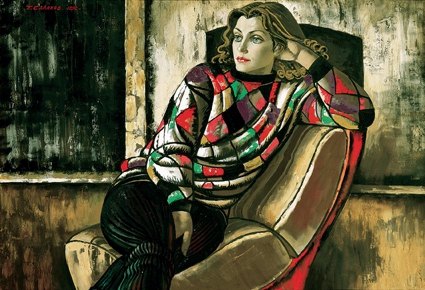
Tahir Salahov continued... His later works are more peaceful and lyrically contemplative, and Eastern influences are more apparent, as in Portrait of Grandson Dan (1983, Mustafayev Azerbaijan State Art Museum), in which the composition and colouring are subordinate to the flowing rhythms of Eastern medieval miniatures. His lines became smoother and more melodious, his palette more sophisticated. Many of his most successful works are associated with his impressions of foreign countries (e.g. Mexican Corrida; 1969, Mustafayev Azerbaijan State Art Museum). He also produced expressive drawings and stage designs. Today Salahov lives in Moscow, where he is a professor and has a studio at the Moscow Art Institute. He has received numerous honors, including People's Artist of USSR, Russia and Azerbaijan, Hero of Socialist Labour, USSR State Prize (1968), First Secretary of the Union of Artists of the USSR (1973 – 1992), Vice-President of the Russian Academy of Arts, member of over 20 academies and other creative organizations throughout the world, including academies of art of France, Spain, Germany, Austria etc.
Artwork by Tahir Salahov
Tahir Salahov - Morning Train - 1958
Sara AshurbeyliSara Balabey qizi Ashurbeyli (Born January 27th 1906, Baku – Died July 17th 2001, Baku) was a famous Azerbaijani scholar, historian and orientalist and artist. Daughter of a rich oil magnate, Sara Ashurbeyli had a perfect education and finished Jeanne D’Arc College in Istanbul in 1925 and entered Baku State University in 1930 this time in Soviet Azerbaijan. Graduated as an orientalist, she also studied European languages in Azerbaijan Pedagogical Institute, thus besides her native Azerbaijani language she knew Arabic, Persian, Turkish, French, German, Russian, and English. As an artist Sara Ashurbeyli became a member of the Union of Azerbaijan’s Artists in 1946. During her lifetime she also taught in various institutions and was a dean for a while. She got her Ph.D. in 1966. Her famous works include “History of Baku: mediaeval period” and “Shirvanshah state”. She died in 2001 at age 96.
Lesser Known Azerbaijan Artists
| |||||
